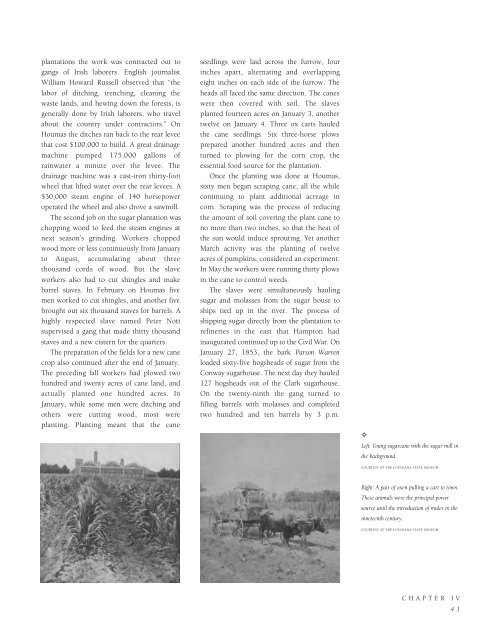Historic Louisiana
An illustrated history of Louisiana, paired with the histories of companies, families and organizations that make the state great.
An illustrated history of Louisiana, paired with the histories of companies, families and organizations that make the state great.
Create successful ePaper yourself
Turn your PDF publications into a flip-book with our unique Google optimized e-Paper software.
plantations the work was contracted out to<br />
gangs of Irish laborers. English journalist<br />
William Howard Russell observed that “the<br />
labor of ditching, trenching, cleaning the<br />
waste lands, and hewing down the forests, is<br />
generally done by Irish laborers, who travel<br />
about the country under contractors.” On<br />
Houmas the ditches ran back to the rear levee<br />
that cost $100,000 to build. A great drainage<br />
machine pumped 175,000 gallons of<br />
rainwater a minute over the levee. The<br />
drainage machine was a cast-iron thirty-foot<br />
wheel that lifted water over the rear levees. A<br />
$30,000 steam engine of 140 horsepower<br />
operated the wheel and also drove a sawmill.<br />
The second job on the sugar plantation was<br />
chopping wood to feed the steam engines at<br />
next season’s grinding. Workers chopped<br />
wood more or less continuously from January<br />
to August, accumulating about three<br />
thousand cords of wood. But the slave<br />
workers also had to cut shingles and make<br />
barrel staves. In February on Houmas five<br />
men worked to cut shingles, and another five<br />
brought out six thousand staves for barrels. A<br />
highly respected slave named Peter Nott<br />
supervised a gang that made thirty thousand<br />
staves and a new cistern for the quarters.<br />
The preparation of the fields for a new cane<br />
crop also continued after the end of January.<br />
The preceding fall workers had plowed two<br />
hundred and twenty acres of cane land, and<br />
actually planted one hundred acres. In<br />
January, while some men were ditching and<br />
others were cutting wood, most were<br />
planting. Planting meant that the cane<br />
seedlings were laid across the furrow, four<br />
inches apart, alternating and overlapping<br />
eight inches on each side of the furrow. The<br />
heads all faced the same direction. The canes<br />
were then covered with soil. The slaves<br />
planted fourteen acres on January 3, another<br />
twelve on January 4. Three ox carts hauled<br />
the cane seedlings. Six three-horse plows<br />
prepared another hundred acres and then<br />
turned to plowing for the corn crop, the<br />
essential food source for the plantation.<br />
Once the planting was done at Houmas,<br />
sixty men began scraping cane, all the while<br />
continuing to plant additional acreage in<br />
corn. Scraping was the process of reducing<br />
the amount of soil covering the plant cane to<br />
no more than two inches, so that the heat of<br />
the sun would induce sprouting. Yet another<br />
March activity was the planting of twelve<br />
acres of pumpkins, considered an experiment.<br />
In May the workers were running thirty plows<br />
in the cane to control weeds.<br />
The slaves were simultaneously hauling<br />
sugar and molasses from the sugar house to<br />
ships tied up in the river. The process of<br />
shipping sugar directly from the plantation to<br />
refineries in the east that Hampton had<br />
inaugurated continued up to the Civil War. On<br />
January 27, 1853, the bark Parson Warren<br />
loaded sixty-five hogsheads of sugar from the<br />
Conway sugarhouse. The next day they hauled<br />
127 hogsheads out of the Clark sugarhouse.<br />
On the twenty-ninth the gang turned to<br />
filling barrels with molasses and completed<br />
two hundred and ten barrels by 3 p.m.<br />
✧<br />
Left: Young sugarcane with the sugar mill in<br />
the background.<br />
COURTESY OF THE LOUISIANA STATE MUSEUM.<br />
Right: A pair of oxen pulling a cart to town.<br />
These animals were the principal power<br />
source until the introduction of mules in the<br />
nineteenth century.<br />
COURTESY OF THE LOUISIANA STATE MUSEUM.<br />
CHAPTER IV<br />
41
















